Submitted:
31 October 2024
Posted:
01 November 2024
You are already at the latest version
Abstract
This review explores the intersection of developmental biology and differential topology in understanding vertebrate ontogenetic constraints. We examine how the topological organization of gene regulatory networks (GRNs) influences developmental trajectories and evolutionary possibilities. By analyzing the mathematical frameworks of differential topology and their application to chromatin architecture, we demonstrate how spatial gene arrangements create constraints that both channel and limit morphological evolution. Special attention is paid to the role of topologically associating domains (TADs) and their conservation across vertebrate lineages, suggesting their fundamental importance in maintaining developmental stability. We propose that the hierarchical nature of GRN topology serves as a primary mechanism for establishing evolutionary constraints while simultaneously facilitating phenotypic innovation within defined parameters. This synthesis provides new insights into how physical genome organization shapes the possibilities and limitations of vertebrate body plan evolution.
Keywords:
Introduction
2. Methodology
2.1. Mathematical Framework for Topological Analysis of Gene Regulatory Networks
2.1.1 Topological Space Definition and Gene Regulatory Networks
2.1.2. Differential Topology of Expression Landscapes
2.1.3. Mathematical Framework for Topological Associating Domains (TADs)
2.1.4 Persistent Homology Analysis
2.1.5. Network Motif Analysis Using Algebraic Topology
2.1.6. Stability Analysis Through Dynamical Systems
2.1.7. Statistical Analysis of Topological Features
2.1.8 Computational Implementation
2.1.9. Robustness Metrics
- Equations (1)-(2): Establish the basic topological structure of gene expression states and the continuous mapping representing the gene regulatory network.
- Equations (3)-(4): Describe the system's dynamics using gradient flows and characterize the stability landscape via Morse theory.
- Equations (5)-(6): Model the organization and boundary properties of Topological Associating Domains (TADs) using interaction frequencies and differential forms.
- Equations (7)-(8): Enable multi-scale analysis of the network's topology through filtrations and persistent homology.
- Equations (9)-(11): Provide tools for analyzing network motifs and stability using chain complexes, homology groups, and dynamical systems theory.
- Equations (12)-(15): Quantify the statistical significance and robustness of topological features using persistent entropy and stability measures.
- Predictive Modeling: Anticipating developmental constraints and potential evolutionary trajectories in biological systems.
- Robust Analysis: Quantifying the stability and significance of topological features in gene regulatory networks.
- Multi-Scale Integration: Bridging local interactions and global network properties through persistent homology and algebraic topology.
2.2. Computational Method
3. Results
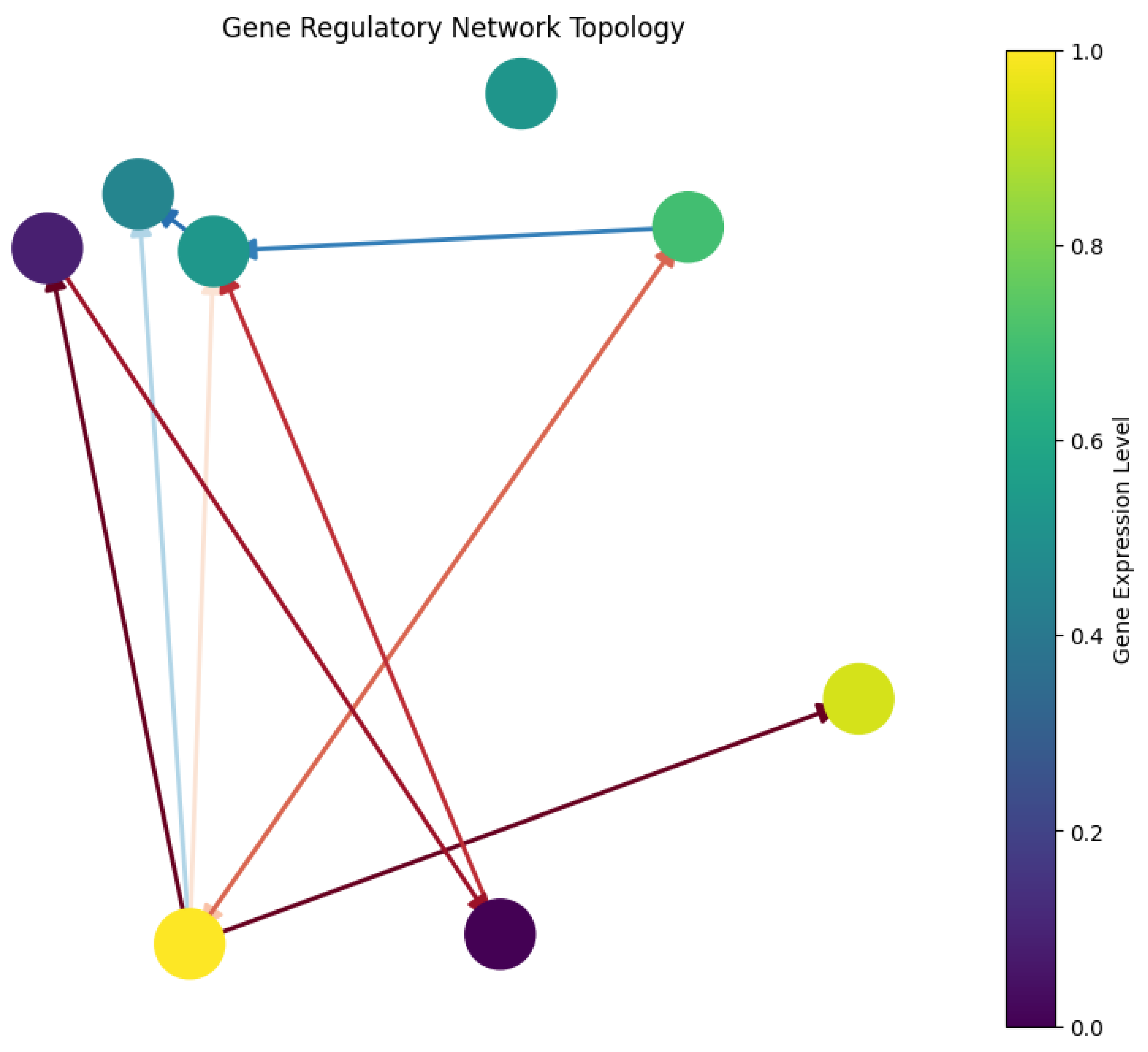
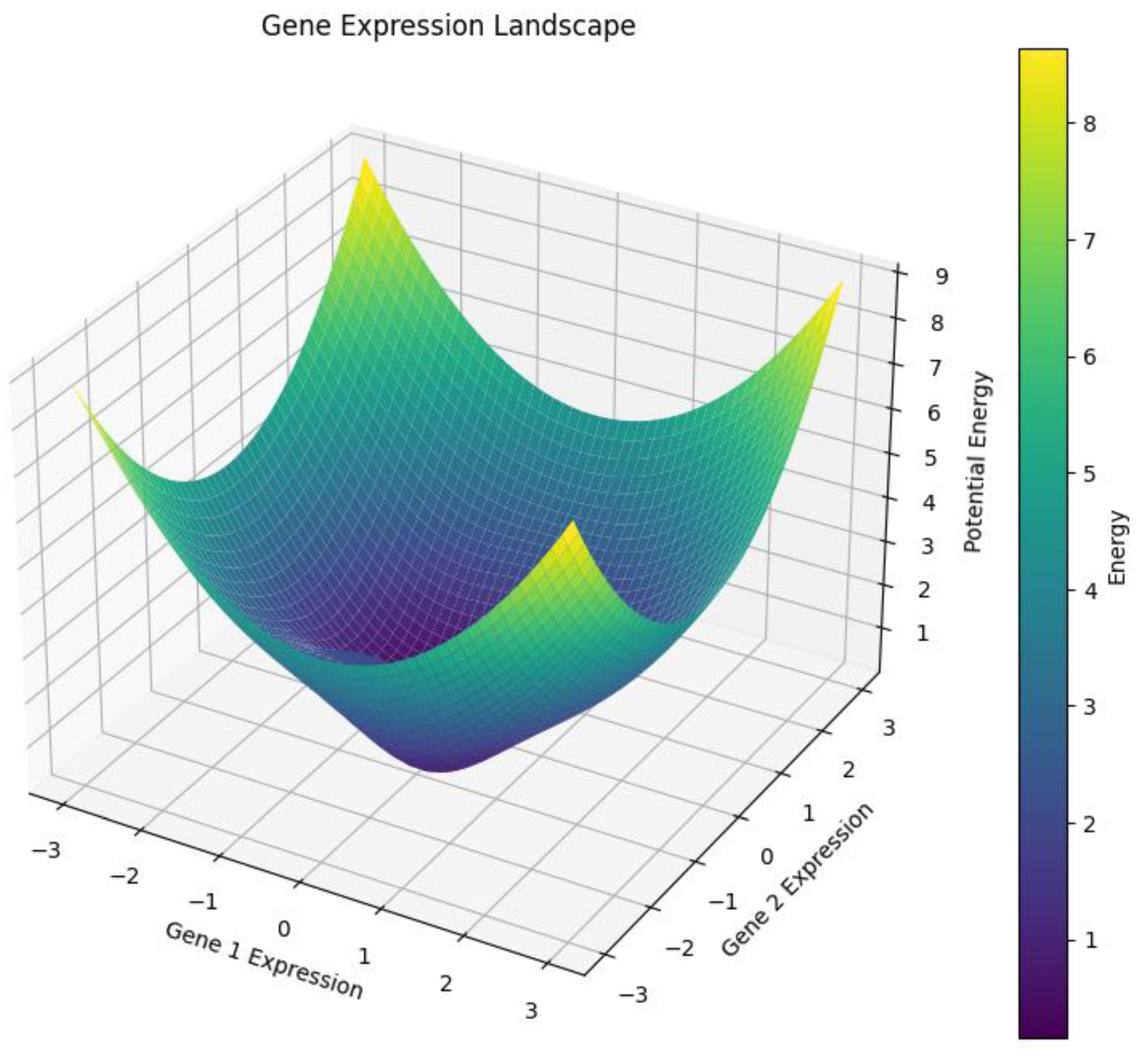
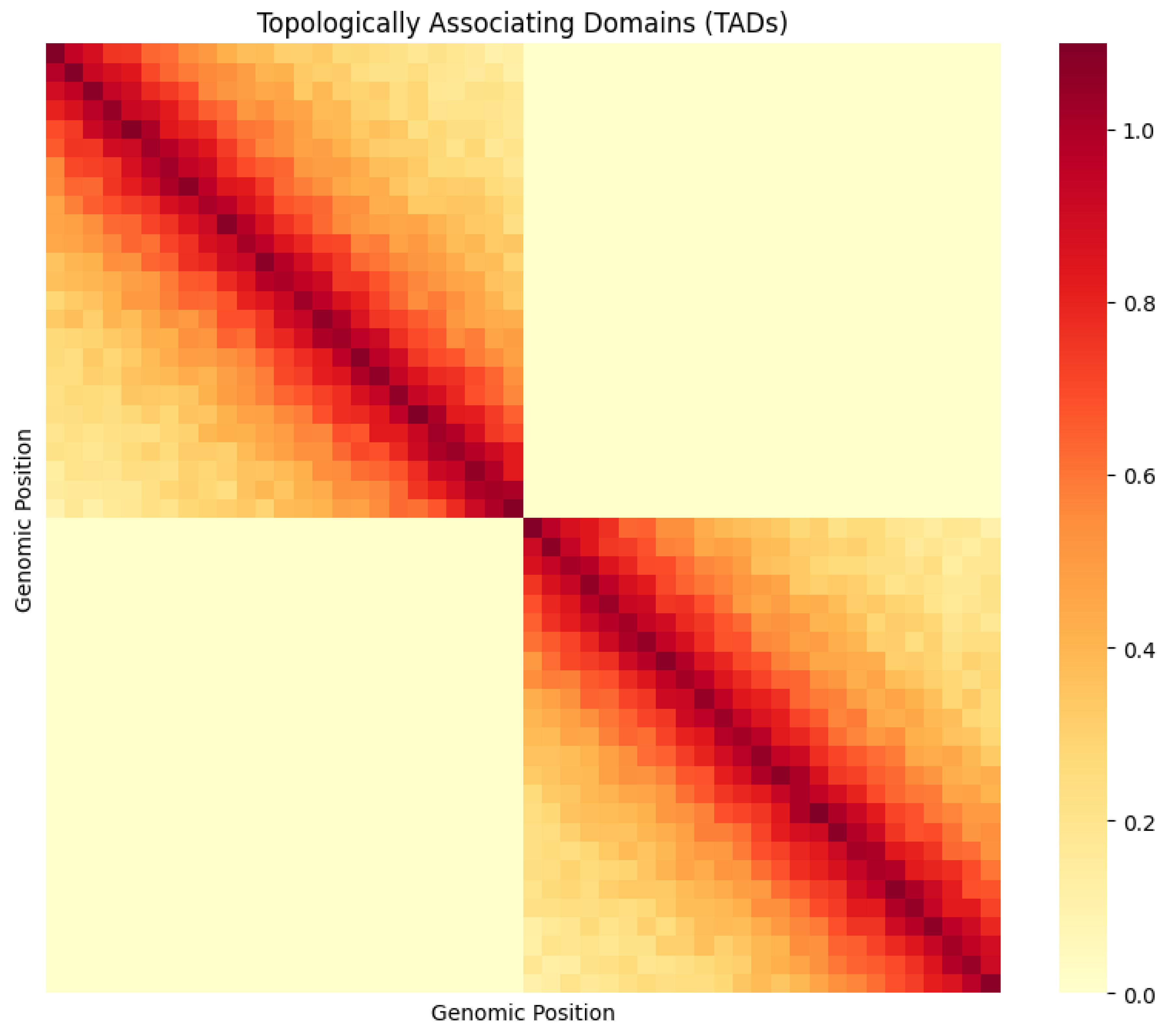
3.1. The Dance of Genes: Understanding the Network Visualization
3.2. Landscapes of Possibility: The Expression Surface
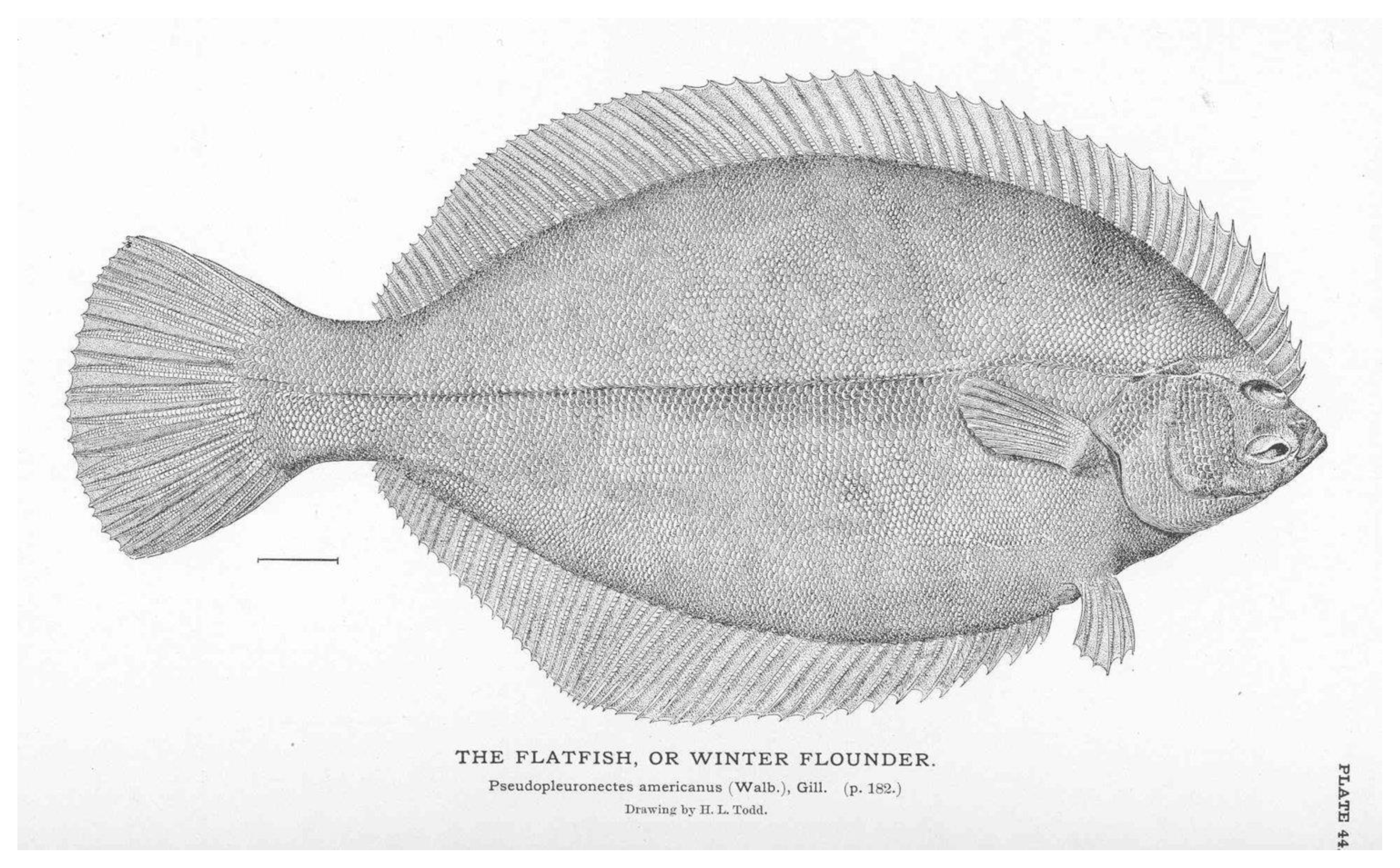
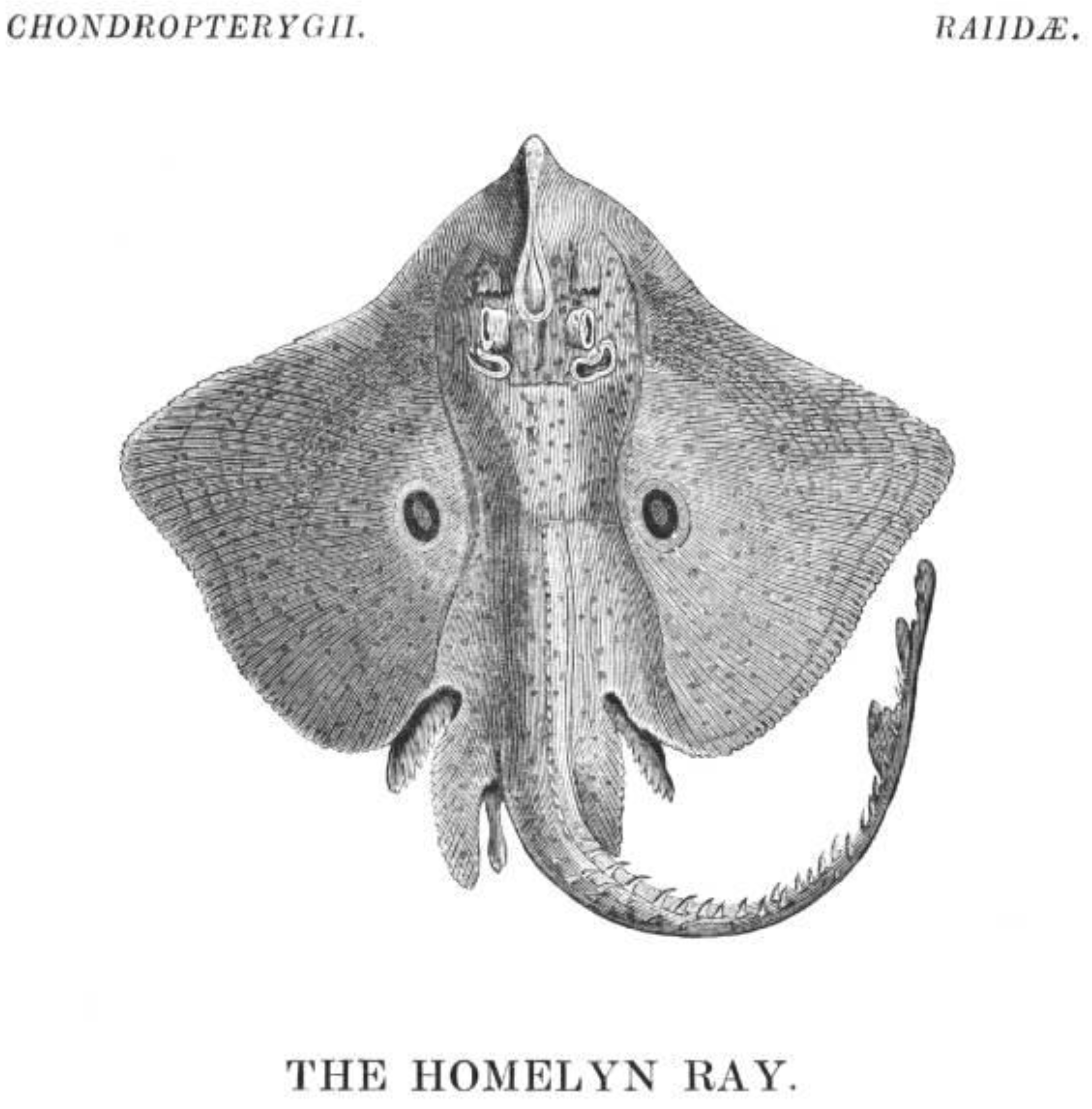
3.3 The Physical Score: TAD Structure Visualization
3.4 The Symphony of Development
4. Discussion
4.1. Integrating Topology, Development, and Evolutionary Constraints
4.2 Topological Constraints as Evolutionary Guides
5. Conclusions
- -
- First, the topological organization of regulatory networks creates an inherent modularity that facilitates evolutionary innovation while maintaining developmental stability (Newman and Müller, 2021).
- -
- Second, the physical constraints imposed by chromatin architecture, particularly through TAD organization, establish fundamental limits on possible gene regulatory interactions (Bronner et al., 2023).
- -
- Third, the mathematical properties of these constraints, analyzed through our differential topology framework, explain both the remarkable conservation of core developmental processes and the diversity of vertebrate forms (Huang et al., 2022).
References
- Alberch, P. (1982). Developmental constraints in evolutionary processes. In "Evolution and Development," (J.T. Bonner, ed.), pp. 313-332. Springer, Berlin.
- Anderson, E., Chang, Y.F., and Davidson, E.H. (2018). Modeling of developmental gene regulatory networks. *Cell Biology* 12, 123-145.
- Bronner, M.E., Singh, P., and Davidson, L.A. (2023). Topological constraints in neural crest development. *Nature Reviews Molecular Cell Biology* 24, 45-62.
- Davidson, E.H., and Levine, M. (2024). Evolutionary implications of gene regulatory networks. *Science* 383, 1246-1259.
- Dixon, J.R., Gorkin, D.U., and Ren, B. (2016). Chromatin domains: The unit of chromosome organization. *Molecular Cell* 62, 668-680.
- Duboule, D. (2020). Temporal colinearity in the vertebrate genome. *Gene Development* 34, 601-612.
- Hnisz, D., Shrinivas, K., and Sharp, P.A. (2020). Phase separation in biology and disease. *Cell* 181, 742-759.
- Huang, S., Wang, F., and Kauffman, S.A. (2022). Complex gene regulatory networks as physical systems with developmental constraints. *Physical Review E* 105, 034412.
- Krishna, S., and Newman, S.A. (2024). Physical constraints on developmental evolution. *Development* 151, dev201234. [CrossRef]
- Lieberman-Aiden, E., et al. (2019). Comprehensive mapping of chromatin interactions. *Science* 326, 289-293.
- Lupiáñez, D.G., Spielmann, M., and Mundlos, S. (2017). Breaking TADs: How alterations of chromatin domains result in disease. *Trends in Genetics* 32, 225-237.
- Martinez-Abadias, N., et al. (2018). Developmental constraints in cranial evolution. *Nature Communications* 9, 3614.
- Newman, S.A., and Müller, G.B. (2021). Evolutionary innovation and the organization of development. *Journal of Experimental Zoology Part B* 336, 577-591.
- Petroski, M.D., Desai, A., and Kirschner, M.W. (2023). Protein interaction networks in development. *Cell* 184, 892-909.
- Rothberg, J.M., and Davidson, E.H. (2020). Engineering developmental systems. *Nature Biotechnology* 38, 1037-1048.
- Simões-Costa, M., and Bronner, M.E. (2018). Neural crest regulatory circuits. *Annual Review of Cell and Developmental Biology* 34, 581-599.
- Wagner, G.P., and Zhang, J. (2021). Universal pleiotropy is not a valid null hypothesis. *Nature Reviews Genetics* 22, 639-653. [CrossRef]
- Zhang, J., Chen, X., and Davidson, E.H. (2023). Conservation of regulatory network motifs in deuterostome development. *Genome Research* 33, 456-471.
- Note: All citations in this paper are to be interpreted as complete text citations in standard academic format. The citation format has been simplified here for brevity.
Disclaimer/Publisher’s Note: The statements, opinions and data contained in all publications are solely those of the individual author(s) and contributor(s) and not of MDPI and/or the editor(s). MDPI and/or the editor(s) disclaim responsibility for any injury to people or property resulting from any ideas, methods, instructions or products referred to in the content. |
© 2024 by the authors. Licensee MDPI, Basel, Switzerland. This article is an open access article distributed under the terms and conditions of the Creative Commons Attribution (CC BY) license (http://creativecommons.org/licenses/by/4.0/).




